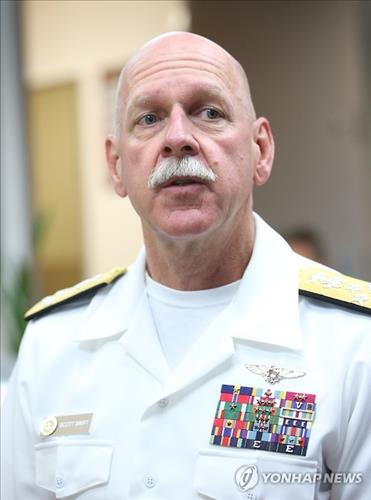- California Assembly OKs highest minimum wage in nation
- S. Korea unveils first graphic cigarette warnings
- US joins with South Korea, Japan in bid to deter North Korea
- LPGA golfer Chun In-gee finally back in action
- S. Korea won’t be top seed in final World Cup qualification round
- US men’s soccer misses 2nd straight Olympics
- US back on track in qualifying with 4-0 win over Guatemala
- High-intensity workout injuries spawn cottage industry
- CDC expands range of Zika mosquitoes into parts of Northeast
- Who knew? ‘The Walking Dead’ is helping families connect
US hails Korean deal as ‘best mechanism’ for solving conflicts
SEOUL (Yonhap) — The commander of the United States’ Pacific Fleet hailed the inter-Korean talks that ended weeks of military tensions Tuesday, saying it is the “best mechanism” for Asian countries to settle conflicts.
“Both North Korea and South Korea have come together to discuss their differences, and I think this is the best mechanism for going forward if conflicts were to break out” in the Asia Pacific region, U.S. Navy Adm. Scott Swift said in a press conference with Asian journalists conducted over the phone.
He was responding to a reporter’s question on how the U.S. would react if conflict broke out in the South China Sea or the broader Asian region.
“That’s really a policy question that is so dependent upon how a conflict might evolve,” Swift said, refusing to answer the question directly.
He, instead, cited the current inter-Korean tensions as an example, adding that “I am very heartened by the most recent development.”
The Pacific Fleet commander also stressed the U.S.’ commitment to deterring potential North Korean attacks.
“The Pacific Fleet units are there being commanded by the 7th Fleet commander in support of Gen. (Curtis) Scaparrotti, and his responsibility for U.S. forces on the peninsula is close collaboration with Republic of Korea forces,” Swift said.
Upon agreements reached in a high-level dialogue earlier in the day, the two Koreas suspended their acts of hostilities at the border at noon to end a weeks-long military standoff triggered by the North planting land mines on the southern side of the demilitarized zone that detonated on Aug. 4.
On Aug. 20, the countries had a rare exchange of live fire across the border before putting their forces in a full-scale combat readiness posture at the border.
As tensions spiraled, South Korea and the U.S. had considered deploying a long-range bomber fitted with bunker-busting bombs, a B-52 Stratofortress, or a nuclear-powered submarine to show off the allies’ military force against North Korea.
















